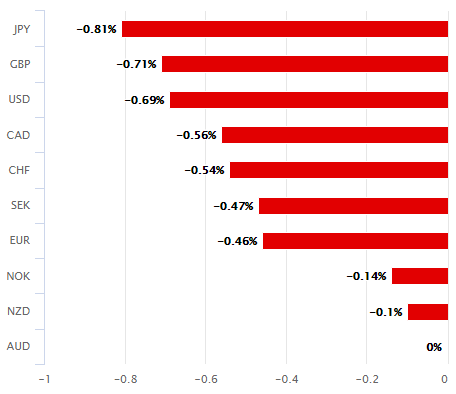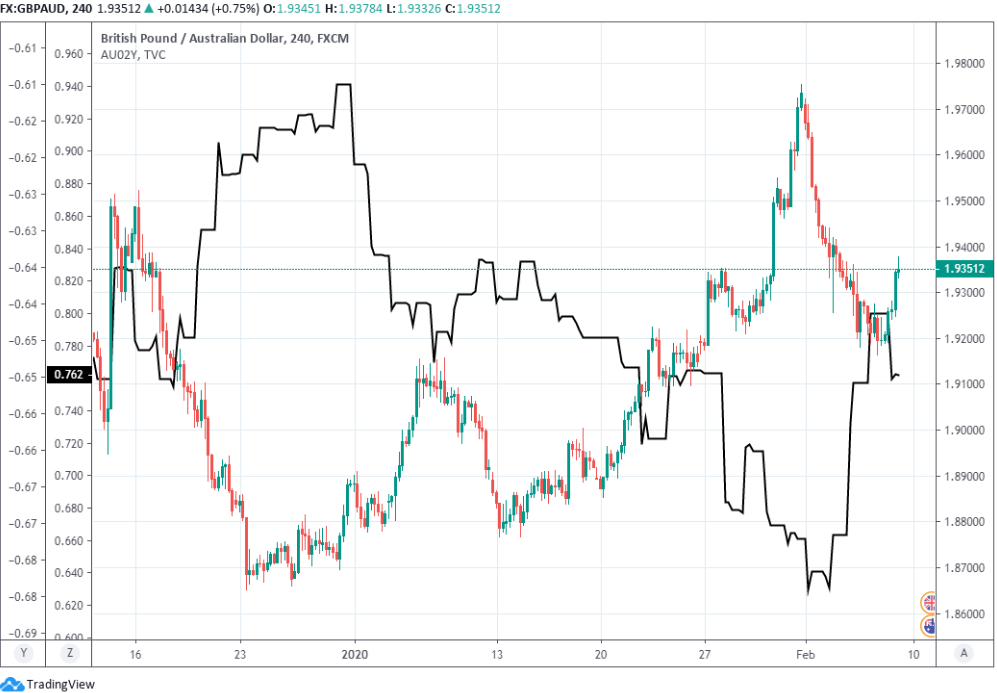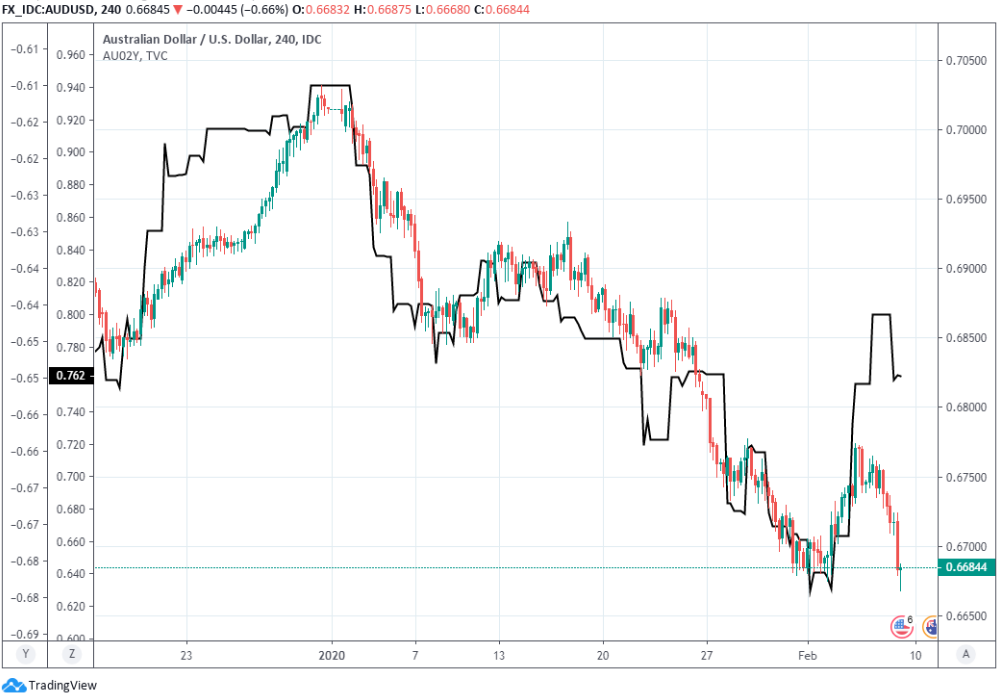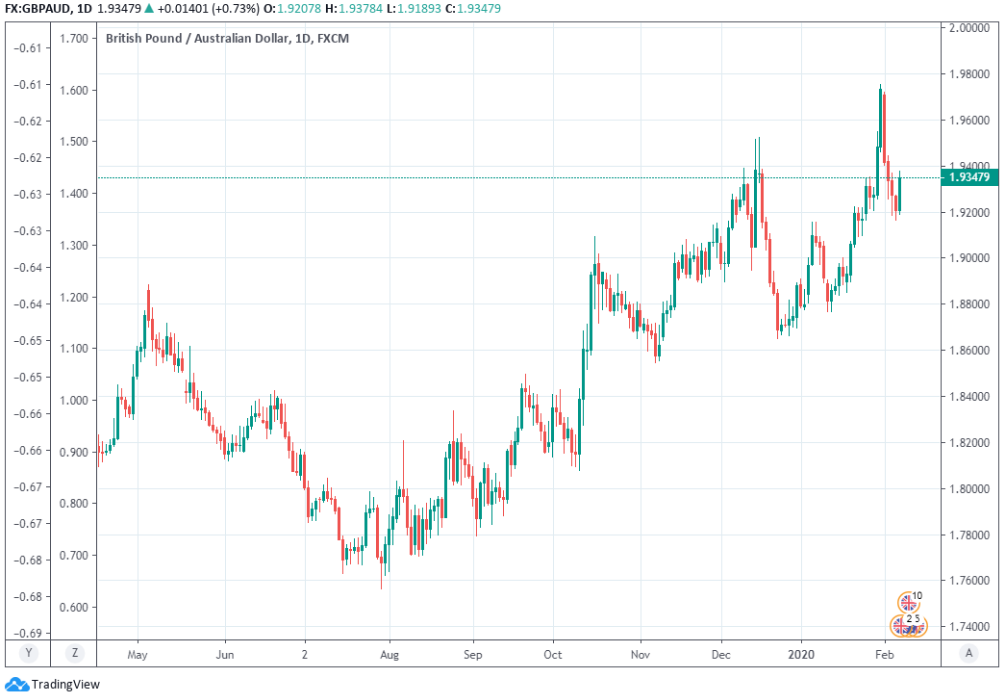Australian Dollar Caves amid Global Profit-taking Ahead of the Weekend
- Written by: James Skinner
-
- AUD slides toward weekend on worldwide wave of profit-taking.
- Risk assets retreat from highs ahead of payrolls and Friday close.
- AUD now the 2nd best performer on the week, behind only USD.
- But RBA repricing creates new AUD vulnerability to weak data.
- Fears of coronavirus have faded but weekend newsflow is a risk.

Image © Adobe Images
- GBP/AUD Spot Rate: 1.9350, up 0.74% today
- Indicative bank rates for transfers: 1.8671-1.8806
- Indicative broker rates for transfers: 1.9058-1.9174 >> find out more about this rate.
Australian Dollar gains were swept away by a worldwide wave of profit-taking ahead of the weekend on Friday although it’s still the second best performer of the last five days due to fading coronavirus fears and a steep repricing of the Reserve Bank of Australia (RBA) interest rate outlook.
The Pound-to-Australian Dollar rate was 0.77% higher in the morning session Friday as the Brexit-battered and economically-ailing Pound recovered from Thursday’s losses while the antipodean unit corrected lower in the wake of strong earlier gains. And in the process other price action has seen the U.S. Dollar relegate the Aussie to its new position as the second best performing major currency for the week.
“The pound is down across the board this week, but substantial losses can be seen against the USD, AUD, CNH and ZAR, all of which have depreciated over 2%,” says George Vassey, a strategist at Western Union. “We have witnessed oil prices lurch 1%-4% on a daily basis for over a week now amidst varying risk appetite, which has kept commodity-linked currencies vulnerable to erratic price action too. The AUD, NZD, CAD and NOK have all experienced a volatile week.”
Australian Dollar performance against major rivals Friday. Source: Pound Sterling Live.
Australia’s Dollar benefited this week from a sell-off in the bond market that lifted yields and boosted the attractiveness of the currency to investors. That came as fears over the coronavirus faded, rightly or wrongly, and as the RBA encouraged an upward move in market-implied cash rates for the months ahead.
However, that repricing of the RBA outlook has now baked a meaningful dose of optimism into the Australian Dollar’s cake, optimism that may yet prove to be misplaced. And in the process price action has left the Aussie with a heightened vulnerability to bad economic data and a deterioration of coronavirus newsflow that Westpac has already told clients to begin positioning for.
“We see such dips as an opportunity to buy AU rates, based on our expectation that a rising unemployment rate, a persistently subdued consumer and shaky global growth will prompt the RBA to cut twice before year end,” says Robert Rennie, head of strategy at Westpac. “There are a few reasons why the [USD] has been so firm lately. An impressive array of data have been reassuringly upbeat, ISM surveys, ADP payrolls and durable orders point to a better starting point for the economy ahead of the China 2019-nCoV Q1 hit.”
Above: Pound-to-Australian Dollar rate shown at 4-hour intervals alongside 2-year Australian bond yield.
Friday’s Aussie correction comes ahead of January’s non-farm payrolls report from the U.S., which will either temper or further encourage what has been an increasingly apparent bid for the U.S. Dollar over recent days. That bid hasn’t so much reflected safe-haven flows this time, but rather mounting evidence of renewed U.S. economic exceptionalism ahead of likely first-quarter blow for the global economy from the coronavirus that’s brought China near to a standstill.
U.S. economic growth was a steady 2.1% in the final quarter last year while sentiment-focused surveys of the manufacturing and services industries have suggested strongly that the world’s largest economy may have actually gained momentum in January.
That’s a problem for other currencies but especially low-yielders like the Euro, Yen, Sterling and also more recently, the Aussie too. Especially as the incoming data from the economies underlying those latter currencies is increasingly pointing to a year-end slowdown early in what could be a tough 2020.
Above: AUD/USD rate shown at 4-hour intervals alongside 2-year Australian bond yield.
“Testimony to parliament today and the release of quarterly update of forecasts in the Monetary Policy Statement have made clear to the markets that the RBA is currently very reluctant to ease its monetary policy stance further. The risks of easing “have slightly tilted to outweigh the benefits,” says Derek Halpenny, head of research, global markets EMEA and international securities at MUFG. “The 2-year yield dropped a touch today reflecting some scepticism along with ongoing coronavirus fears...That will limit any positive response to the RBA update.”
Expectations of more rate cuts and an eventual turn to quantitative easing had weighed on the Aussie for months although this week the RBA suggested strongly that it doesn’t intend to provide any more stimulus in the short-term. The market-implied cash rate for August 04 rose from 0.40% in late January to 0.53% Thursday, but fell to 0.50% Friday.
The actual cash rate is still 0.75% so market pricing implies a wager that at least one cut is certain for 2020, but that it's unlikely to come until the second half of the year. Halpenny says markets will continue to bet on rate cuts ahead but that global factors will be a more important influence on the Australian Dollar.
Above: Pound-to-Australian Dollar rate shown at daily intervals.
That leaves the Aussie vulnerable to a continued strength in the U.S. economy and greenback as well as a possible deterioration of coronavirus newsflow over the weekend, not to mention poor economic data in the months ahead.
Aussie interest rate markets are not pricing any economic growth or monetary policy fallout from the coronavirus, although there will certainly be a global economic hit from it and the situation is far, far, far from over.
“The RBA have hilariously used their Statement on Monetary Policy this morning to make clear that rates are on hold right now, and that further rate cuts could do more harm than good with only two left in the can before QE has to start. I always guessed these guys spent all day on the Domain.com property website, but the timing is pure black comedy, as is their call that the unemployment rate will be going down and not up just as Chinese tourism collapses. On which note, today has already seen Japanese household spending collapse -4.8% y/y in December before anyone even sneezed,” says Michael Every, a Hong Kong-based strategist at Rabobank. "There is an attempt to try to look on the bright side of the virus headlines. Chinese officials are spreading the word globally that things are under control and that other countries should not be closing their borders to China...Of course, at home China is still under draconian lockdown."













